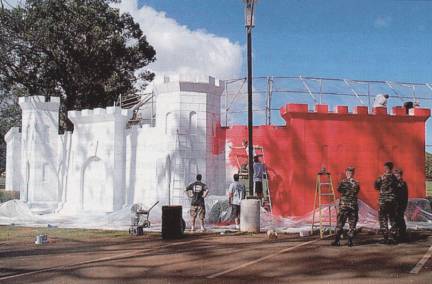Strength, pride, heraldry, prestige, and honor. The castle remains the premier symbol of the U.S. Army Corps of Engineers. The medieval castle is inseparably connected with fortifications and architecture. In heraldry, the castle and the tower are often used on coats of arms. In this country the term “castle” has been applied to the strongest of our early fortifications such as Castle Pinckney in Charleston, South Carolina, and Castles Williams and Clinton in New York Harbor.
The Corps Castle is a highly stylized form without decoration or embellishment. The Army unofficially adopted the castle to appear on the Corps of Engineers’ epaulets and belt plate in 1840. Soon afterwards the cadets at West Point, all of whom were part of the Corps of Engineers until the Military Academy left the charge of the Chief of Engineers and came under the charge of the Army at large in 1866, also wore the castle on their cap beginning in 1841. Subsequently, the castle appeared on the shoulder knot, on the saddlecloth, as a collar device, and on the buttons. Finally, in 1902, the castle was formally adopted by the Army as the insignia of the Corps of Engineers. Although its design has changed many times since its inception, the castle has remained the distinctive symbol of the Corps of Engineers.
Excerpted from The Military Engineer, Vol. 94, No. 618, Jul./Aug. 2002
The distinctive Corps castle structures shown below are but a few examples that can be found in various cities and countries around the world.
| This engineer castle was constructed between 1938 and 1941 by elements of the 3rd Engineer Combat Regiment’s 65th Engineer Battalion at Schofield Barracks, Hawaii. The castle served as a grandstand for the stadium on the installation’s Ralston Field. After years of weathering, B Company, 65th Engineer Battalion restored the structure to its original glory. The renovated castle remains as a tribute to the soldiers who built it 67 years ago. Photo courtesy of 2nd Lt. Fred Schwark. |
 |
| The Engineers’ Castle in Washington Park Zoo (Michigan City, Indiana) was dedicated on May 6, 1937. The structure was built during the Great Depression with labor funded by the WPA, CWA, and FERA. Excavation of the site began in December 1933, and the castle was completed in 1936. The 309th Engineer Regiment, 84th Division, a World War I unit, placed a plaque on the building. It reads: "In grateful appreciation to the people of Michigan City for having erected this Engineer Castle, for over one hundred years the official insignia of the Corps of Engineers United States Army." In 2019 the castle underwent an extensive restoration with the help of KIL Architecture–Professional Architectural Services to bring back its historic outdoor appearance and upgrade the interior animal exhibit space. Photo courtesy of Washington Park Zoo. |

|
| This “memorial” to the U.S. Army’s 343rd Engineer General Service Regiment was constructed in the woods of Highmoor, Oxfordshire, England, prior to D-Day 1944. In honor of the engineers’ sacrifices, Highmoor villagers continue to care for it. Photo courtesy of Ray Woodhouse, England. |
 |
| The Castle Gatehouse at Georgetown Reservoir was built in 1902. Its brickwork was originally covered with Portland Cement plaster blocked off to represent stonework. Photo courtesy of Washington Aqueduct Division. |
 |
* * *
August 2004; Revised July 2021. No. 090.